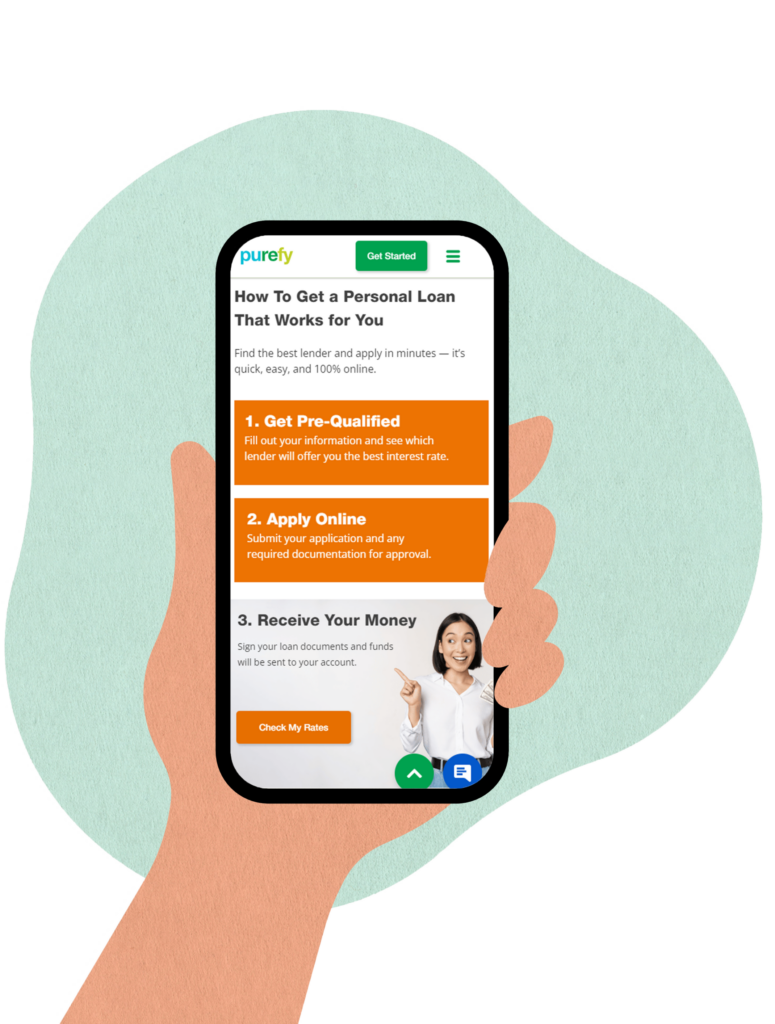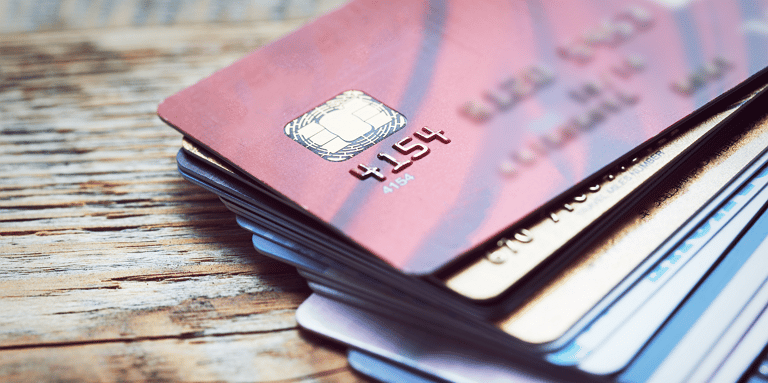Credit cards can provide a lot of value in the form of rewards and perks. But credit card debt can be a slippery slope, and it’s easy for a small balance to get out of control if you only make minimum payments.
On average, Americans carry $5,589 in credit card debt, according to data from the credit bureau Experian. A little more than 4 in 10 credit cards are revolvers, according to the American Bankers Association, which means that the card user carries a balance from month to month.
If you’re struggling with credit card debt, a personal loan may be able to help you eliminate it more quickly and possibly even save you money along the way. Here’s what you need to know about using a personal loan to pay off credit cards.
How to use a personal loan to pay off credit card debt
A personal loan is a versatile form of funding that you can use for just about anything you want. One potential way to use a personal loan is for high-interest debt consolidation, such as credit card balances.
In fact, when you see the term “consolidation loan,” it’s generally referring to a personal loan.
When you get approved for a personal loan, the lender will typically deposit the money in your checking account, which you can then use to pay off your credit card balances. In some cases, lenders may even offer to make the payment directly to your creditors, so you don’t have to take that extra step.
Moving forward, you’ll have a set repayment schedule with your new loan, which will be based on the loan amount, interest rate, and repayment term.
Debt Consolidation Example
To give you an idea of how using a personal loan to pay off credit card debt can be beneficial, let’s say that you have $10,000 in credit card debt with an average interest rate of 20% and a minimum monthly payment of $275.
If you make only the minimum payment without adding additional debt to the cards, you’d pay off the debt in 57 months and spend roughly $5,500 on interest.
But let’s say you can qualify for a four-year personal loan with an 8% interest rate and no origination fee. With this option, your monthly payment would be about $244, you’d pay off the debt nine months sooner, and you’d only pay about $1,718 in interest — a savings of over $3,700.
Debt Consolidation Calculator
Personal loans can be used to consolidate your debt into a single loan with a new rate and term. See how much you can save by entering your loan information below.
Step 3: See How Much You Can Save
| Current Debt | Personal Loan | Savings | |
|---|---|---|---|
| Monthly Payment | $600 | $483 | $117 |
| Lifetime Interest | $5,400 | $2,399 | $3,001 |
| Time to Payoff Debt | 2 yrs 10 mos | 3 yrs | 2 mos |
Want to compare personalized prequalified rate offers from top personal loan companies? We’ve partnered with Credible to help get your finances back on track with free rate comparisons — with no impact on your credit score.
The pros and cons of using personal loans to pay off credit cards
As the example above shows, using a personal loan to pay off credit card debt can be beneficial in a few ways. But it’s important to understand that there are both benefits and drawbacks to consider before you apply for a personal loan.
Pros
You could save money
On average, a two-year personal loan has an interest rate of 8.73%, according to the Federal Reserve. In contrast, the average credit card interest rate is nearly double that at 16.65%. Depending on which rate you qualify for, you could potentially save thousands of dollars in interest charges by using a personal loan to pay off credit card debt.
You’ll get a set repayment term
One of the primary issues with credit cards is that they give you a minimum payment but no set repayment schedule. This arrangement makes it easier to carry a balance from month-to-month, and it could keep you in debt for years — especially if you keep making purchases with the card. With a personal loan, you know exactly when you’ll be debt-free, and you’ll have a set plan to get there.
You’ll have a simpler monthly payment
If you have multiple credit cards, consolidating your balances means that you’ll only have one payment instead of several. More importantly, personal loans typically have fixed interest rates, which means that your payment will stay the same throughout the life of the loan. Not only do credit cards typically have variable interest rates, but your minimum monthly payment is calculated based on your balance. Your monthly credit card payment may actually go down over time, making it harder to pay off the debt if you aren’t actively trying to pay off the balance.
It can help your credit score
By paying off your existing credit card debt, you’ll increase your credit utilization, which is a major contributing factor toward your credit score. Keeping up with the monthly payments on your new loan will also improve your credit score over time.
Cons
You may not qualify for a better rate
Personal loan interest rates are based on your creditworthiness, so unless you have good credit, you may not qualify for a low enough interest rate to save money. If you have fair credit or even poor credit, interest rates can be as high as 36% with many lenders.
The monthly payment may be unaffordable
While the monthly payment for a personal loan could be cheaper than a credit card payment, that won’t always be the case, especially with shorter repayment terms. If you can’t afford the monthly payment on a personal loan, it could result in missed payments, which can damage your credit.
It doesn’t solve the main problem
While a personal loan can potentially help you pay down your credit card debt faster and even save you money, it’s only a temporary solution to your debt problem. In addition to paying down your debt aggressively, it’s important to rethink your approach to credit cards to prevent yourself from digging yourself an even deeper hole.
How to choose the best personal loans to pay off credit cards
When shopping for a personal loan to pay off credit card debt, there are a few important items to consider before choosing a lender. Here’s what you need to know to make the best decision for your needs.
Find the Lowest Interest Rates
It may seem obvious, but it’s important to shop around and compare options from different lenders to find the lowest interest rate. If you’re using a personal loan to pay off credit card debt, doing so only makes sense if you are able to get a lower interest rate than your current credit card APRs. To compare personal loan offers from multiple lenders, you can use our rate comparison tool to shop 15+ lenders with one form and no impact on your credit score.
What are the Repayment Terms?
Personal loan repayment terms tend to be shorter than other types of loans, like mortgages or student loans. Repayment terms are typically one to seven years, although longer-term loans are possible. With a personal loan, you can choose the repayment term and monthly payment that fits your budget, and by having a fixed monthly payment, you’ll know exactly when you’ll be debt-free.
Loan Amount Maximums and Minimums
In addition to flexible repayment terms, personal loans are offered in a wide range of amounts – our partner lenders can issue a personal loan for as little as $600 or as much as $100,000. When shopping for a lender, you’ll want to consider the amount the lender is offering you in addition to the interest rate. This is especially important when using a personal loan to pay off credit card debt, as you may not be approved for the entire amount of your existing debt that you wish to consolidate.
Look at the Loan Fees
Personal loans often come with an origination fee, although not all lenders charge this fee. Pay attention to the origination fee along with any other potential fees, like prepayment penalties or late fees. None of our partner lenders charge prepayment penalties, but some do charge origination fees.
Outsmart Rising Credit Card Interest Rates With a Personal Loan
Credit card APRs often exceed 20%. Get your finances on the right track today with a quick & easy personal loan from our marketplace of top-rated lenders
5 tips when using a personal loan to pay off credit card debt
If you’ve decided that a personal loan makes sense for your debt consolidation needs, here are some tips that can help you make the most of your plan.
1. Build your credit first
Before applying for a personal loan, check your credit reports to see where you stand and determine if you need to make improvements. You can get your FICO Score and Experian credit report for free through Experian’s credit monitoring service.
With that information on hand, pinpoint areas where you can improve, such as paying down some of your larger balances or disputing inaccurate credit report information.
While waiting may not be ideal, increasing your credit score can help you maximize your savings.
2. Stop using your credit cards
If possible, try to stop using your credit cards while you work to pay down your debt. Otherwise, it can feel like you’re taking two steps forward and one step back.
In situations where you need credit cards to get by because your income is too low or your expenses are too high, look for areas of your budget where you can cut back to try to minimize the new debt you’re adding to your cards.
3. Shop around for the lowest personal loan interest rates
It’s crucial that you take the time to shop around and compare personal loan offers to ensure that you get the best deal available to you. Fortunately, many personal loan companies offer a prequalification tool, but it can be time-consuming to do this with each individual lender.
Instead, compare personal loans with Purefy to see offers side-by-side through one easy form. Comparing rates will not hurt your credit, and you’re under no obligation to proceed with a loan.
4. Watch out for fees
Some personal loans come with an origination fee, which can range from 1% to 10% of the loan amount. Lenders usually deduct this fee from your loan disbursement, which means that if you were to borrow $10,000 with a 6% origination fee, you’d only get $9,400, which isn’t enough to cover your credit card balances.
Fortunately, many lenders offer personal loans without an origination fee, so you can easily avoid one, especially if you have great credit.
If you are facing an origination fee, divide your loan amount by 100% minus the origination fee to make sure you borrow enough. With the example above, you’d divide $10,000 by 0.94 to get $10,639.
5. Make plans to avoid credit card debt in the future
Every situation is different, and in some cases, an individual’s credit card debt may be a result of circumstances outside of their control.
However, it’s important to consider your situation and take steps to avoid future credit card debt so you don’t end up in this predicament again. While closing credit cards can have a negative impact on your credit score, the long-term benefits of avoiding high-interest debt can far outweigh that drawback.
The bottom line
If you’re struggling with credit card debt, you may have a lot of different options to deal with it, including personal loans. If you’re thinking about using a personal loan to consolidate your credit card debt, it’s important to consider both the advantages and disadvantages that you’ll face.
It’s also crucial to take your time to research other options, including balance transfer credit cards, the debt avalanche or snowball method, a debt management plan and more.
If you’ve done this and determined that a personal loan is the best option for you, compare multiple loan offers before deciding on a lender. Consider interest rates, fees, repayment terms, monthly payments, and other features to ensure you’re getting the best deal and the payments fit within your budget.
While using a personal loan to pay off credit card debt can take some time, it can ultimately help improve your financial health and well-being.
Credit Card Debt Piling Up?














